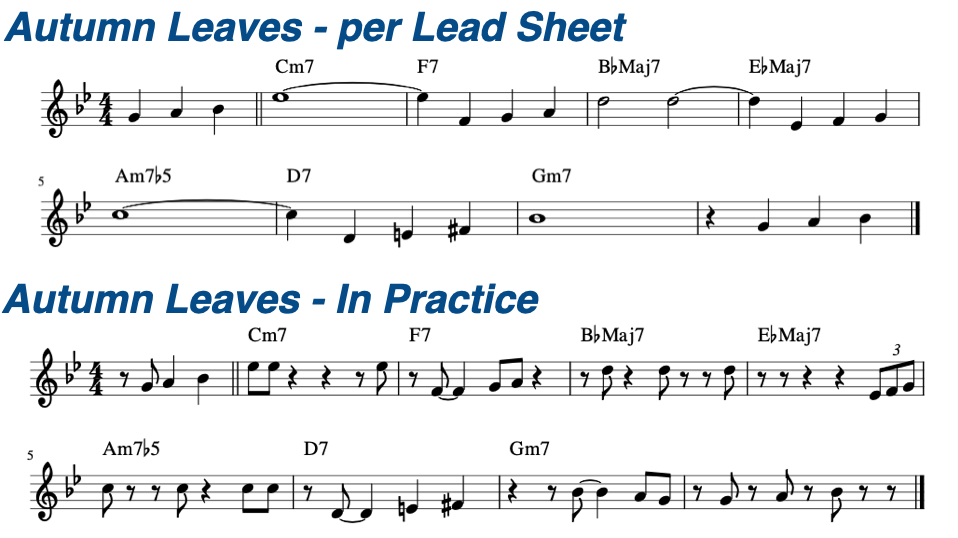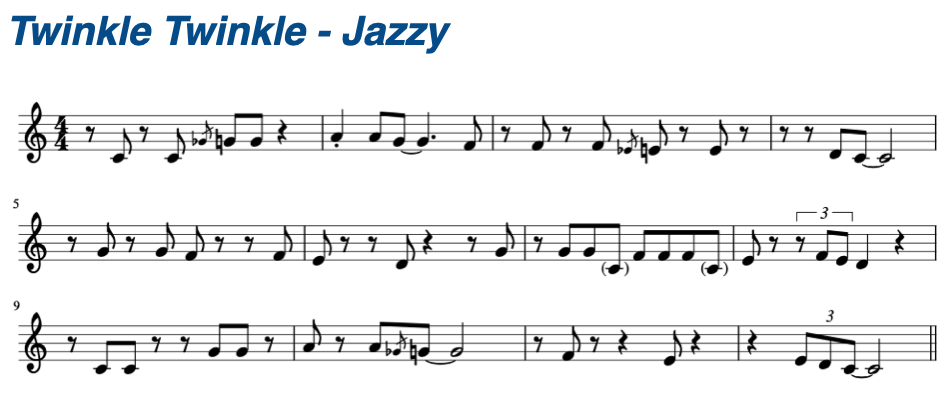Jazz Articulation
Jazz articulation is not about what you play, but rather how you play. That is – not playing the right note, but playing the note right. Having proper phrasing and articulation in your lines helps add a rhythmic component to your playing and really separates intermediate and advanced players from beginners. Just like a monotonic speaker is incredibly boring, so a monotonic improvisation is.
Rhythmic Layers
Ultimately, the way to develop good articulation is by listening to a lot of jazz and trying to mimic and mirror the soloists lines. But there are, of course, exercises you can do to improve your articulation. Remember, we are note interested is what we are playing, but rather in how we play. Specifically, we want to focus on accenting notes occasionally. The idea here is to superimpose a layer of rhythmic patterns over the notes we are actually playing. To do this, we will practice playing a phrase and accent every nth note – and then another phrase, and so on. And for the purposes of this exercises, just use swung eighth notes.
Accenting Exercise
For example, we could play a 6 note phrase and accent every 3rd note, starting on note 1 (so accenting notes 1 & 4).

Or play a 9 note phrase and accent every 4th note, starting on note 1 (so accenting notes 1, 5 & 9).

We can also accent asymmetrically, say by playing a 13 note phrase and accenting one notes 1, 6, 9, & 13.

But, of course, you don’t have to accent the first note, your first accent could be on the 2nd or 3rd note.

There are no hard and fast rules here, but I would generally accent every 2-5 notes, so as to not leave too long in between accents (and thus avoid having your phrase sound monotonic). And, of course, you don’t have to use only eighth notes – you can use notes of any duration, but the same principle applies. You can also combine this concept (accenting every nth note) to the melodic continuity exercise, or to your favourite lick or riff and see which variation you prefer.
Jazz Rhythm
Now let’s discuss Jazz rhythm more generally. To make a melody sound jazzy, it doesn’t matter what notes you play, rather the rhythm with which you play them. This is particularly important because lead sheets often simplify the melody so that notes land on-the-beat. This makes the melody easier to read, but also makes it sound boring. In practice, you wouldn’t play the melody like this, instead you would vary the rhythm to make a more rhythmically interesting and complex variation of the melody. An example of this is shown below with Autumn Leaves.

We can break ‘rhythm’ up into a number of components:
- Macro-Rhythm
- Swing rhythm – we want to generally use a swing rhythm
- Syncopation – we want to accent off-beats to create a sense of syncopation
- Note Duration
- We want to use primarily eighth notes & triplets
- But we can use longer notes at end of phrases
- Also insert longer rests/pauses to create a sense of space
- Note Placement
- Use a combination of on & off-beat notes
- Start & end phrases on an off-beat
- Anticipate & delay notes by 1/2 beat
- Phrases that start on an off-beat, play a few notes on-the-beat, and finish on an off-beat are particularly effective because they help establish a feeling of syncopation
- Articulation
- Use bouncy/punchy/marcato notes – not quite staccato, but not legato (unless you’re playing a ballad)
- Occasionally accent notes (on & off-beat) to create a rhythmic layer above your melody (as described above)
- Ornamentation
- Use Ghost notes, Grace/crushed notes, Trills, Turns, Glissandi, Tremolos, etc.
Let’s take another example and look at how we might play Twinkle Twinkle in a jazzy style (just looking at the melody – not the harmony). Instead of playing every note on the beat, we can apply the above ideas and create something like this:

Jazz Articulation
Jazz Rhythm